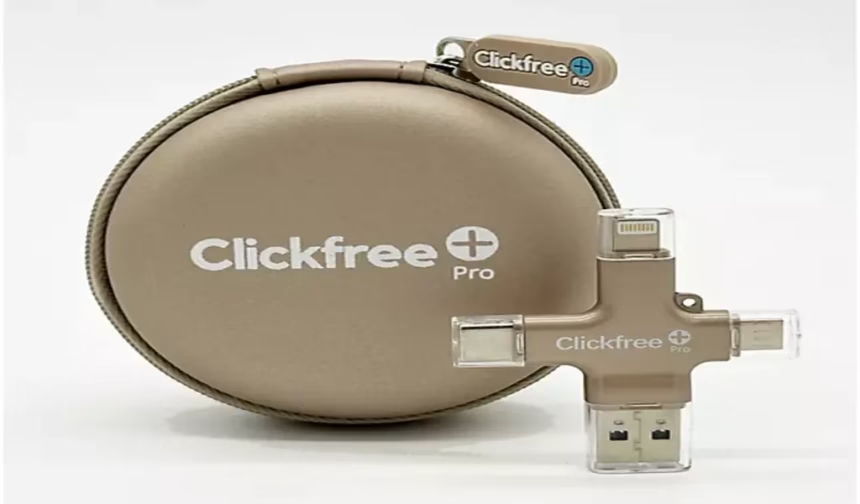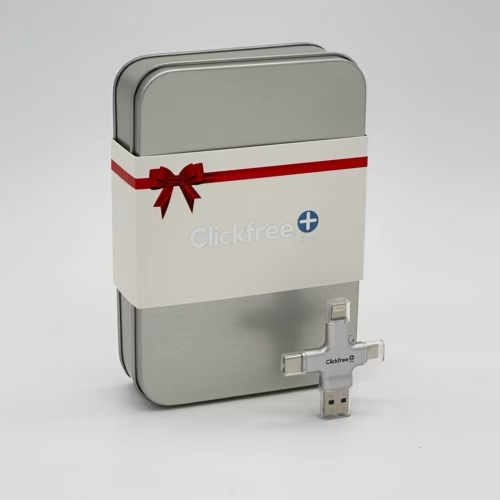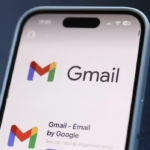Wondering what ClickFree Pro is? See what it means, safety checks, and the best trusted alternatives for backup, browsing, and marketing.
Wondering what clickfree pro is? The name shows up in a few places. Most people use it to talk about a hardware backup drive, but some also use it for browser add-ons or marketing tools. This guide clears up what the name means, checks safety in one minute, and gives trusted alternatives for backup, browsing, and ads work.
Summary at a glance:
- Most often: a USB backup drive for phones, tablets, and computers
- 60-second safety check: verify seller, scan with VirusTotal, test in a guest account
- Best trusted alternatives: Backblaze, iDrive, Apple Time Machine, Microsoft File History, Acronis
Quick Answer: What does clickfree pro usually mean
Most people use this name for a simple USB backup and storage device that works with phones, tablets, and computers. It is still sold in 2025 in multiple sizes. It usually includes built-in connectors for iPhone, Android, USB-C, and USB-A. The goal is simple backups for photos, videos, contacts, and files.
In short, it acts like a pocket drive, freeing up storage on a phone or moving files between devices. It keeps data offline, which lowers cloud risk. That said, no tool is risk-free. Follow the safety checklist below before buying or installing anything with a similar name.
What it typically does:
- One-touch photo and video backup
- Free up phone space quickly
- Move files between phones, tablets, and computers
- Keep data offline, with no monthly fee
There was also an older “Clickfree” backup brand in the 2010s. On top of that, some browser extensions or ad tools use similar names to sound simple. Always verify the product you mean.
Why is the name confusing
Names stick around. Retailers list bundles, rebrands, and variants with similar titles. Some extensions or tools borrow the “clickfree” phrasing to suggest one-click ease.
Three quick checks to avoid mix-ups:
- Check device photos and ports. Look for Lightning, USB-C, and USB-A.
- Check the seller or developer name. Make sure it matches the brand site or store listing.
- Read permissions for apps or extensions. If they look too broad, walk away.
Keep reading for the 60-second safety checklist to make a confident choice.
If You Mean the Old Clickfree Backup Brand
The original one-click Clickfree drives from the early 2010s appear to be discontinued. Software updates are unlikely to support current macOS or Windows versions. If someone still owns one, the hardware may work, but software can be the sticking point.
For a smooth experience on modern devices, consider current, supported tools. The comparison table below offers clear choices.
How it worked
- Plug the external drive into a PC or Mac.
- The bundled software started on its own.
- It scanned shared folders like Documents, Pictures, and Desktop.
- It ran scheduled or one-click backups.
People liked the simple setup and the lack of monthly fees.
Pros and cons
Pros:
- Simple setup with one-click behavior
- Local control of files
- No subscription fees
Cons:
- Old hardware and software
- App and drivers may not support the current macOS or Windows
- No off-site copy if the drive is lost or damaged
Safe, modern backup alternatives
Here are trusted, supported tools in 2025. Choose based on your budget, platform, and preferred data storage.
Backup tools comparison table
| Tool | Platform | Type | Price range | Best for |
|---|---|---|---|---|
| Backblaze | Windows, macOS | Cloud | Budget monthly plan | Set-and-forget cloud backup for one computer |
| iDrive | Windows, macOS, mobile | Cloud | Budget yearly plans | Families, multi-device backup, and snapshots |
| Apple Time Machine | macOS | Local | Free with macOS, plus the cost of the drive | Mac users who want simple local backups |
| Microsoft File History | Windows | Local | Free with Windows, plus the cost of the drive | Windows users who wish to create versioned local backups |
| Acronis | Windows, macOS | Local or cloud | Mid to Premium | Power users who wish to have imaging and extra features |
If You Mean a Browser Extension, App, or Marketing Tool
Some readers search for a “speed-up” extension or an ad tool named like ClickFree Pro. That can be risky if the developer is unknown. Use the red flags below and test safely.
Red flags and permission checks
Common red flags:
- Unknown developer and vague site
- Broad permissions, like “Read and change all your data”
- Off-store installers or zip downloads
- Fake or copy-paste reviews
- Aggressive pop-ups and forced opt-ins
Simple 4-step check:
- Find the official store page
- Read permissions line by line
- Scan installers on VirusTotal
- Test in a separate user account first
How to vet claims and pricing
For marketing or ad tools, slow down and verify:
- Company details, address, and support options
- Plan limits, data policy, and refund terms
- Real case studies, not just logos
- Start monthly, not yearly, until trust is earned
Quick checklist to print:
- Who owns it?
- What data does it take?
- What limits exist?
- Can the plan be canceled quickly?
- Any unbiased case studies?
- What happens to the data on cancellation?
Safer tools that do the job
- Use built-in browser features first. Chrome, Edge, and Safari include tracking protection, clear cache, and site data controls.
- For backups, see the table above for well-known options.
- For cleanup, try Windows Storage Sense and macOS Storage Management.
Decision flow: Backup, browser, or marketing?
- Saving photos or freeing phone space? Pick a backup solution.
- Fewer ads or faster pages? Review browser settings and safe content blockers.
- Growing ad clicks or tracking? Vet marketing tools with the pricing and data checklist.
- Unsure? Start with local backup plus a cloud plan for safety.
- Always test new apps in a guest account first.
Is Clickfree Pro Safe? A 60-second Checklist
This is a quick HowTo checklist for non-technical readers.
- Find the official retailer or developer name
- Check HTTPS and basic company info on the site
- If downloading an installer, scan the file on VirusTotal
- Read requested permissions before Install
- Check the 10 most recent reviews
- Back up key files first
- Install in a guest account or on a secondary device
- Uninstall fast if it shows ads, toolbars, or nags
How to Choose the Right Tool for Your Goal
Keep it simple. Match your goal to the tool type, then set rules that protect your files.
- Follow the 3-2-1 backup rule: 3 copies, two different types, one offsite.
- Use local backups for fast restores.
- Add cloud backup to protect against theft, fire, or loss.
- Set weekly schedules. Test a restore once a month.
Mid-article CTA: Download the free 1-page backup checklist (PDF).
For backups: home, students, and small businesses
- Local backups are fast and cheap, good for daily saves.
- Cloud backups protect against loss, theft, or damage.
- Hybrid mixes are both for strong coverage.
- Home photos and videos: local drive plus Backblaze or iDrive.
- Students: protect school projects and notes with File History or Time Machine.
- Small business: invoices and client files need to be off-site. Add Backblaze or iDrive.
- Keep one copy away from home or office.
For faster browsing or cleanup
- Clear cache and cookies.
- Remove extensions that haven’t been used in the last month.
- Turn on tracking protection in your browser.
- Avoid “speed booster” apps with vague claims or bundles.
For marketing or ad tasks
- Use trusted platforms and analytics.
- Start with small budgets, then scale.
- Track cost per lead and conversion rate.
- Avoid tools that want admin access without a clear need.
- Keep contracts monthly until results are proven.
Related reading and mid-article CTA
Related reading:
- Learn practical defenses with these essential email security tools for businesses.
CTA: Download the free 1-page backup checklist (PDF).
FAQs
What is ClickFree Pro?
Most often, it is a simple USB backup device for phones, tablets, and computers. The name can also appear on unrelated tools, so verify the seller.
Is ClickFree Pro safe?
Local storage lowers cloud exposure, but users should still follow the 60-second checklist, verify sellers, and scan installers. There are no guarantees.
Is ClickFree Pro still supported?
The modern hardware product was sold in 2025 with app updates. The older Clickfree brand from the 2010s appears to be discontinued.
What are the best ClickFree Pro alternatives?
For backups, consider Backblaze, iDrive, Apple Time Machine, Microsoft File History, or Acronis. See the comparison table above.
How do I check if a download is safe?
Get it from the official store, read permissions, scan with VirusTotal, and test in a guest account first.
Final Thoughts
- In most cases, “clickfree pro” refers to a plug-in USB backup tool for phones and computers.
- Names can be reused, so verify the seller and scan installers fast.
- Follow the 60-second checklist to reduce risk.
- For reliable backups, start with Time Machine or File History and add a cloud plan like Backblaze or iDrive for an off-site copy.
Want simple, safe tech each week? Subscribe for weekly safety tips and simple tech guides.
















